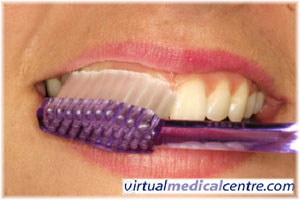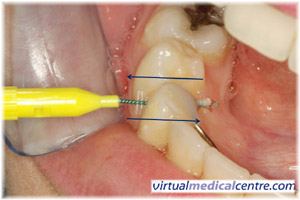- Why is developing good dental hygiene important?
- How to maintain good dental hygiene
- Where does the dentist fit into good oral hygiene?
- Key points to remember
Why is developing good dental hygiene important?

Dental plaque and dental calculus
Dental plaque is a white-ish substance that develops every day, and adheres to teeth. It is mostly found on the gum line, or in between teeth. It is composed mainly of microscopic bacteria, food, and saliva, and it matures and becomes a problem if one eats a carbohydrate and sugar rich diet (source of nutrition for bacteria) or does not adequately clean their teeth.
Dental calculus is a form of hardened dental plaqueand is caused by the continual accumulation of minerals from saliva. It causes a roughened and hard covering over the tooth, which allows more plaque to adhere to teeth, and potentially cause or exacerbate problems.
The problems of dental plaque and dental calculus
Dental caries(tooth decay)
Tooth decay occurs when small holes (cavities) form in the tooth due to the accumulation of dental plaque. When the sugar and carbohydrates that are a part of our diet comes into contact with plaque, the result is acid formation. Over time, if the combination of plaque and an acidic environment is left to occur, tooth decay will result.
Gum disease
Gum disease refers to any infection or inflammation of the gums surrounding the teeth, although it is mostly a result of an accumulation of dental plaque. Healthy gums are pink and do not hurt or bleed when brushed. Unhealthy gums are open to the bacteria in plaque causing an inflammation called gingivitis. Gingivitis is a reversible condition, in that if the plaque is removed completely, the problem will solve itself. If the tissues that connect the teeth to the gums (bone, ligaments etc.) become involved, then it is called periodontitis – this step is irreversible.
Bad breath (halitosis)
Halitosis, the technical term for bad breath, is also often the result of unhealthy plaque build up. Halitosis can be a result of many medical conditions. Dental plaque-related halitosis results when the gums become infected or inflamed due to the bacteria in plaque. Keeping the teeth and gums clean, and even brushing the tongue may prevent this condition.
How to maintain good dental hygiene
Good dental hygiene means getting into the routine of thoroughly cleaning the mouth at least once or twice a day, though preferably after every meal. The following discussion considers some important aspects of keeping teeth clean such as brushing, flossing, mouthwashes, and other adjuncts to maintaining good dental health.
Brushing
Brushing teeth for two full minutes with fluoride toothpaste and a brush that is small enough to manoeuvre around the inside, outside and top of every tooth in the mouth is considered necessary. Consider listening to an entire song whilst brushing teeth – this will be the appropriate time needed to clean teeth. Replacing a brush every three months has also been shown to be more effective in maintaining good dental health.
When buying a manual toothbrush, use one with soft bristles as this will protect gums from damage to a greater extent. Studies have shown that brushing harder will not remove more dental plaque. Consider investing in an electric toothbrush if more help is needed and it is difficult to use a manual toothbrush. The novelty of a fancy new toothbrush is motivation alone to brush more.
How to brush
- Press gently at a 45-degree angle. Scrub the side closest to the cheek (of the tooth and gum) for a few seconds using a small circular/vibratory motion. In the same manner, move slowly around your mouth until you get to the other side. Pay particular attention to the gum line.
- Once on the other side of the mouth, rotate the brush so that it rests against the tooth and gum (on the side closest to your tongue), and use the same angle and same circular scrubbing motion to return to the first tooth.
- Next, briskly brush along the top surface of the teeth.
- Then repeat the entire process on the upper or lower set of teeth (depending on start position).
- Do not neglect the roof of the mouth and tongue, as these places also harbor bacteria.
- Try to only spit out the toothpaste, rather than rinsing it all out after brushing, as this will reduce the effect of the fluoride in toothpaste.
|
|
| Figure 1: The toothbrush is angled at 45-degrees to the gum and teeth. The brush points upwards when brushing the top teeth and points towards the floor when brushing the lower teeth. Note the bristles of the brush cover the gums and the tooth at the same time when brushing. |
Important considerations when brushing
- Keep a routine and do not rush! It is important to keep routines with oral hygiene; otherwise it is easy to miss areas of the mouth. Unfortunately, the same areas are missed EVERY time and these areas get gum disease. If you start on the top, don’t rush the bottom teeth as these will tend to be worse than the top if this is the case.
- Make sure every tooth surface is cleaned! With the brush, it is possible to clean the top of your teeth, and the sides that are closest to your cheek and tongue! Make sure for every tooth, these surfaces are cleaned.
Flossing
Floss before every brushing. Remember that using just a small bit of dental floss to gently slide debris from between the teeth goes a long way towards eradicating plaque and keeping the mouth free from bacteria.
Floss should be wrapped around the fingers then stretched tightly between the thumbs, or thumb and first finger, of each hand so that it can be eased carefully between teeth. The floss should be moved carefully up and down the side of each tooth, pushing the floss down just under the gum line.
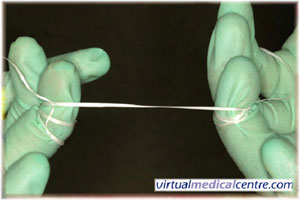 |
 |
| Figure 2: Dental floss wrapped around both middle fingers with a gap of 5-10cm. | Figure 3: Flossing upper teeth. Note thumb and index finger used to floss through contact and then move up and down. |
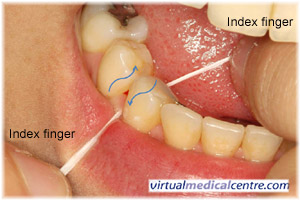 |
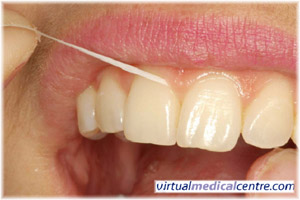 |
| Figure 4: Flossing lower teeth. Note both index fingers used to floss through contact and then move up and down. | Figure 5: Floss continues to just below gum line. |
Other interdental cleaning devices (those devices that clean in between teeth) such as interproximal brushes or wooden or rubber tips are also valuable for certain people including those with missing teeth, large gaps, areas where the gum line has dropped, crowded teeth etc. A dentist is trained to determine the individual needs of a patient, and determine which tool will be the most effective.
|
|
| Figure 6: Interdental pikster or interproximal brush used to clean in between teeth. This is especially useful for people who cannot use conventional dental floss, such as those who have bridges that join teeth together, and/or orthodontic treatment (this person has a metal retainer behind the lower front teeth). |
Mouthwashes
It is important to remember that if one cleans the teeth properly with brushing and flossing, there is no need for a mouthwash. To date, the best mouthwashes include an ingredient known as chlorhexidine gluconate. Any mouthwash with this ingredient should ONLY be used for short periods of time as it has problems such as altering taste, staining teeth and margins of fillings etc. Those mouthwashes containing thymol and cetylpyridinium chloride are effective, but to a lesser degree than chlorhexidine gluconate.
Recently, there has been the heated debate over alcohol containing mouthwash related to oral cancer. Some people have dismissed the link, however, one study in 2008 from an Australian journal proposed a link between oral cancer and mouthwash in non-smokers and non-drinkers, and fuelled the debate over whether dentists should be recommending alcohol containing mouthwashes. More and more companies are releasing alcohol free mouthwashes in light of recent evidence. At the moment, alcohol containing mouthwash does not cause oral cancer; it simply has been linked with a higher incidence in some research.
Gum, lollies, high fluoride toothpaste, and CPP-ACP
If you are unable to clean your mouth directly after eating, consider chewing sugar free gum. This will stimulate saliva in your mouth that will naturally help flush out any lingering remnants of food. Also sugar free lollies will promote a similar mechanism.
High fluoride toothpastes should be used only in consultation with dental advice. They usually have five times the fluoride content of normal toothpaste and are advised in patients who are high-risk to dental decay. Other agents such as CPP-ACP (casein phosphopeptide – amorphous calcium phosphate), which are effective in helping remineralise the tooth, are being promoted in patients prone to erosion, dental decay, and dry mouth.
Where does the dentist fit into good oral hygiene?
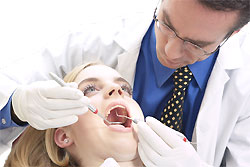
- Recommend cleaning techniques and products;
- Clean plaque and calculus from the teeth;
- Fill cavities that could lead to further tooth decay;
- Administer fluoride treatments;
- Treat mild gingivitis before it turns into periodontitis;
- Take radiographs; and
- Reinforce oral hygiene instruction over long term.
Key points to remember
-
Everyone requires the regular use of a toothbrush and fluoride containing toothpaste, either manual or electric, at least once or twice a day.
- Fluoride is safe in water and toothpaste!! There is less chance of problems if one spits only, rather than rinsing after brushing.
- Soft bristled toothbrushes should be used, and replaced every three months.
- Electric toothbrushes are as effective, if not slightly better than manual toothbrushes.
- Using floss every day, or another device to clean in between your teeth before brushing is essential to maintain good dental hygiene.
- Mouthwashes are not necessary if flossing and brushing are adequate, however those containing chlorhexidine gluconate are most effective if used, but should not be used for long periods of time.
- The dentist is able to determine the best way for every individual to maintain good oral hygiene, and is able to provide feedback and tips.
- It is essential to have 3-12 month visits to the dentist to have dental calculus and dental plaque removed professionally.
Kindly written by Dr Akhil Chandra BDSc. (Hons UWA)
Dentist, Whitfords Dental Centre andEditorial Advisory Board Member of the Virtual Dental Centre
References
- Newman M, Takei H, Klokkevold P. Carranza’s Clinical Periodontology. 10 ed. Carranza F, editor. St Louis: Saunders, Elsevier; 2006.
- Mitchell DA, Mitchell, L. Oxford handbook of Clinical Dentistry. 4th ed. New York: Oxford University Press; 2005.
- Bowen WH. Nature of plaque. Oral Sci Rev, 1976; 9:3-21.
- Oral and Dental Expert Group. Therapeutic Guidelines: Oral and Dental. 1st ed. Dowden J, editor. North Melbourne: Therapeutic Guidelines Limited; 2007.
- Gibbons RJ, Hay DI. Human salivary acidic proline-rich proteins and statherin promote the attachment of Actinomyces viscosus LY7 to apatitic surfaces. Infect Immun, 1988 Feb; 56(2):439-45.
- Master Dentistry. Heasman P, editor. Philadelphia: Elsevier; 2004.
- Loe H, Theilade E, Jensen SB. Experimental Gingivitis in Man. J Periodontol, 1965 May-Jun; 36:177-87.
- Gurenlian JR. Inflammation: the relationship between oral health and systemic disease. Access, 2006; 20(4) suppl: 1-9.
- Wefel JS. Root caries histopathology and chemistry. Am J Dent1994 Oct; 7(5):261-5.
- Featherstone JD. Fluoride, remineralization and root caries. Am J Dent, 1994 Oct; 7(5):271-4.
- Roberson TM, Heymann HO, Swift EJ, Jr., editors. Studervant’s Art and Science of Operative Dentistry. 4th ed. St Louis: McGraw-Hill; 2002.
- Bass CC. An effective method of personal oral hygiene. J La State Med Soc, 1954 Feb; 106(2):57-73.
- Gilson CM, Charbeneau GT, Hill HC. A comparison of physical properties of several soft toothbrushes. J Mich State Dent Assoc, 1969 Nov; 51(11):347-61.
- Khocht A, Simon G, Person P, Denepitiya JL. Gingival recession in relation to history of hard toothbrush use. J Periodontol, 1993 Sep; 64(9):900-5.
- Daly CG, Chapple CC, Cameron AC. Effect of toothbrush wear on plaque control. J Clin Periodontol, 1996 Jan; 23(1):45-9.
- Robinson P, Deacon SA, Deery C, Heanue M, Walmsley AD, Worthington HV, Glenny AM, Shaw BC.Manual versus powered toothbrushing for oral health. Cochrane Database of Systematic Reviews 2005, Issue 2. Art.No: CD002281. DOI: 10.1002/14651858.CD002281.pub2
- Poyato-Ferrera M, Segura-Egea JJ, Bullon-Fernandez P. Comparison of modified Bass technique with normal toothbrushing practices for efficacy in supragingival plaque removal. Int J Dent Hyg, 2003 May; 1(2):110-4.
- Davies RM, Ellwood RP, Davies GM. The rational use of fluoride toothpaste. Int J Dent Hyg, 2003 Feb; 1(1):3-8.
- Gjermo P, Flotra L. The plaque removing effect of dental floss and toothpicks a group-comparison study. J Periodontal Res, 1969; 4(2):170.
- Finkelstein P, Grossman E. The effectiveness of dental floss in reducing gingival inflammation. J Dent Res, 1979 Mar; 58(3):1034-9.
- Lang NP, Cumming BR, Loe H. Toothbrushing frequency as it relates to plaque development and gingival health. J Periodontol, 1973 Jul; 44(7):396-405.
- Drisko CH. Non-surgical pocket therapy: pharmacotherapeutics. Ann Periodontol, 1996 Nov; 1(1):491-566.
- Van Strydonck DA, Timmerman MF, van der Velden U, van der Weijden GA. Plaque inhibition of two commercially available chlorhexidine mouthrinses. J Clin Periodontol, 2005 Mar; 32(3):305-9.
- Lang NP, Hotz P, Graf H, Geering AH, Saxer UP, Sturzenberger OP, et al. Effects of supervised chlorhexidine mouthrinses in children. A longitudinal clinical trial. J Periodontal Res, 1982 Jan; 17(1):101-11.
- Elmore JG, Horwitz RI. Oral cancer and mouthwash use: evaluation of the epidemiologic evidence. Otolaryngol Head Neck Surg, 1995 Sep; 113(3):253-61.
- McCullough MJ, Farah CS. The role of alcohol in oral carcinogenesis with particular reference to alcohol-containing mouthwashes. Aust Dent J, 2008 Dec; 53(4):302-5.
- O’Leary TJ, Drake RB, Naylor JE. The plaque control record. J Periodontol, 1972 Jan; 43(1):38.
- Lenox JA, Kopczyk RA. A clinical system for scoring a patient’s oral hygiene performance. J Am Dent Assoc, 1973 Apr; 86(4):849-52.
- Tedesco LA, Keffer MA, Davis EL, Christersson LA. Effect of a social cognitive intervention on oral health status, behaviour reports, and cognitions. J Periodontol, 1992 Jul; 63(7):567-75.
All content and media on the HealthEngine Blog is created and published online for informational purposes only. It is not intended to be a substitute for professional medical advice and should not be relied on as health or personal advice. Always seek the guidance of your doctor or other qualified health professional with any questions you may have regarding your health or a medical condition. Never disregard the advice of a medical professional, or delay in seeking it because of something you have read on this Website. If you think you may have a medical emergency, call your doctor, go to the nearest hospital emergency department, or call the emergency services immediately.

